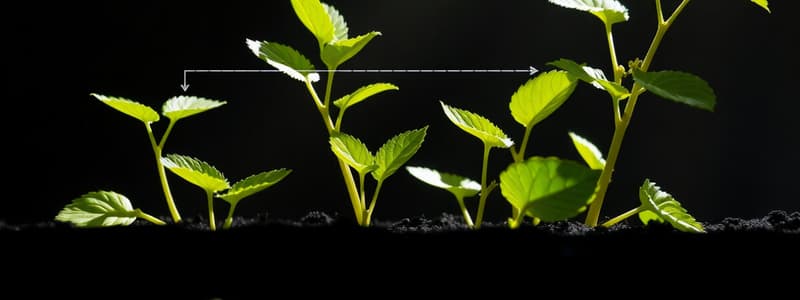Podcast
Questions and Answers
What regulates the opening and closing of stomata in plants?
What regulates the opening and closing of stomata in plants?
- Soil pH levels
- Temperature fluctuations
- Types of photosynthesis utilized
- Environmental cues like water availability (correct)
Which type of photosynthesis is characterized by incorporating CO₂ directly into a 3-carbon molecule?
Which type of photosynthesis is characterized by incorporating CO₂ directly into a 3-carbon molecule?
- C3 photosynthesis (correct)
- CAM photosynthesis
- Light-dependent reactions
- C4 photosynthesis
Which photosynthetic pathway is particularly suited for hot, dry climates?
Which photosynthetic pathway is particularly suited for hot, dry climates?
- C3 photosynthesis
- Photorespiration
- C4 photosynthesis (correct)
- Oxygenic photosynthesis
In CAM photosynthesis, when do plants typically open their stomata to collect CO₂?
In CAM photosynthesis, when do plants typically open their stomata to collect CO₂?
What is a drawback of closing stomata in plants?
What is a drawback of closing stomata in plants?
What are the end products of the photosynthesis process?
What are the end products of the photosynthesis process?
Which stage of photosynthesis is primarily responsible for producing oxygen?
Which stage of photosynthesis is primarily responsible for producing oxygen?
What role do ATP and NADPH play in photosynthesis?
What role do ATP and NADPH play in photosynthesis?
Which factor does NOT directly affect the rate of photosynthesis?
Which factor does NOT directly affect the rate of photosynthesis?
What is the significance of chlorophyll in photosynthesis?
What is the significance of chlorophyll in photosynthesis?
What happens to the rate of photosynthesis when the light intensity exceeds a certain point?
What happens to the rate of photosynthesis when the light intensity exceeds a certain point?
Which pigment is primarily responsible for absorbing light energy in photosynthesis?
Which pigment is primarily responsible for absorbing light energy in photosynthesis?
How does water availability affect photosynthesis?
How does water availability affect photosynthesis?
Flashcards
What are stomata?
What are stomata?
Tiny pores on the surface of leaves that control gas exchange, allowing carbon dioxide to enter for photosynthesis and oxygen to exit.
What is photosynthesis?
What is photosynthesis?
The process where plants use sunlight, water, and carbon dioxide to create their own food (sugar).
What is C3 Photosynthesis?
What is C3 Photosynthesis?
The most common photosynthetic pathway used by most plants. It directly incorporates carbon dioxide into a 3-carbon molecule.
What is C4 Photosynthesis?
What is C4 Photosynthesis?
Signup and view all the flashcards
What is CAM Photosynthesis?
What is CAM Photosynthesis?
Signup and view all the flashcards
Photosynthesis
Photosynthesis
Signup and view all the flashcards
Photosynthesis Equation
Photosynthesis Equation
Signup and view all the flashcards
Light-dependent Reactions
Light-dependent Reactions
Signup and view all the flashcards
Light-independent Reactions (Calvin Cycle)
Light-independent Reactions (Calvin Cycle)
Signup and view all the flashcards
Chlorophyll
Chlorophyll
Signup and view all the flashcards
Carotenoids
Carotenoids
Signup and view all the flashcards
Glucose
Glucose
Signup and view all the flashcards
Oxygen
Oxygen
Signup and view all the flashcards
Study Notes
Photosynthesis Overview
- Photosynthesis is a process where plants and other organisms convert light energy into chemical energy stored in sugars.
- The overall reaction is: 6CO₂ + 6H₂O + light energy → C₆H₁₂O₆ + 6O₂
- This shows CO₂ and water are converted to glucose and oxygen using light energy.
Stages of Photosynthesis
- Photosynthesis has two main stages: light-dependent and light-independent reactions (Calvin cycle).
- Light-dependent reactions: Occur in thylakoid membranes of chloroplasts. They split water, releasing oxygen; ATP and NADPH (energy carriers) are made.
- Light-independent reactions (Calvin cycle): Happen in the stroma of chloroplasts. They use ATP and NADPH to fix atmospheric CO₂ into organic molecules, producing glucose.
Factors Affecting Photosynthesis
- Light intensity: Increased light boosts photosynthesis until a maximum saturation point is reached.
- Carbon dioxide concentration: Higher CO₂ levels initially speed up photosynthesis; this too plateaus.
- Temperature: Photosynthesis has an ideal temperature range. Extreme temperatures hinder enzymes, slowing the process.
- Water availability: Water is critical. Lack of water limits components like initial electron donors, restricting photosynthesis.
Chlorophyll and Pigments
- Chlorophyll is the primary light-absorbing pigment in photosynthesis.
- Other pigments like carotenoids absorb light and transfer energy to chlorophyll. Carotenoids absorb light wavelengths chlorophyll can't.
- Different pigments absorb different wavelengths. Chlorophyll a effectively absorbs red and blue light.
Products of Photosynthesis
- Glucose: The primary product, used for energy and building other organic molecules in the plant.
- Oxygen: A byproduct released into the atmosphere, vital for aerobic respiration in many organisms.
Stomata and Gas Exchange
- Stomata are tiny leaf pores controlling gas exchange.
- Stomata open to allow CO₂ in and O₂ out during photosynthesis.
- Stomata closing conserves water but limits CO₂ intake.
C3, C4, and CAM Photosynthesis
- Different photosynthetic pathways adapt plants to various environments, aiming to reduce water loss.
- C3 photosynthesis: The most common type, directly incorporating CO₂ into a 3-carbon molecule (3PG).
- C4 photosynthesis: Found in hot, dry climates. They concentrate CO₂ to improve CO₂ uptake, reducing photorespiration at high temperatures.
- CAM photosynthesis (crassulacean acid metabolism): Used by succulent plants in arid conditions. Stomata open at night to collect CO₂ stored as organic acids; it's released for the Calvin cycle during the day, preserving water.
Studying That Suits You
Use AI to generate personalized quizzes and flashcards to suit your learning preferences.




